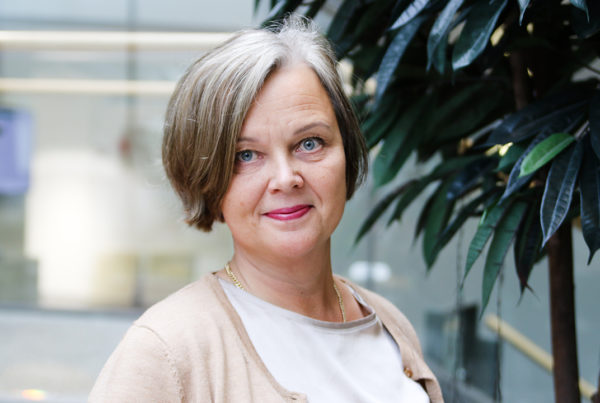A couple of years ago, clinical research in Finland was on the verge of a crisis. The number of clinical trials had more than halved from 2008 to 2014, while at the same time governmental research funding kept dropping drastically, from € 91 million in 1987 to roughly € 20 million in 2015. At the same time, the costs of clinical research were steadily increasing. Mediuutiset, a Finnish healthcare-oriented news service, described the existing situation of clinical research in Finland as a “catastrophe”.
During 2015, however, something changed. Suddenly the number of clinical studies conducted in Finland started to increase again, by as much as 44%, in spite of the fact that the governmental research funding was further cut to reach an all-time low by 2017.
So why the sudden change of course?
To get an insider’s view of what is going on in the field of clinical research in Finland, we went to meet professor Anne Pitkäranta, the Research Director of Helsinki University Hospital. As a professor in otorhinolaryngology, and a clinical researcher herself, Pitkäranta has witnessed the effects of diminishing research resources all too near.
Pitkäranta is convinced that the recovering statistics are at least partially due to university hospitals now being determined to keep clinical research alive. “There has been a major attitude shift in the hospital management”, she says and continues, “High-class clinical research is now appreciated as a critical hospital function, and a competitive advantage rather than just expense.” A positive climate for clinical research, in turn, tends to have an impact on researchers willingness to carry out clinical studies.

Of course, Pitkäranta reminds, it’s not all about attitude. It also seems that after a long downward trend, pharmaceutical companies are starting to increase their research investments in Finland. In May 2016 the Academic Medical Center Helsinki (AMCH), a joint center of Helsinki University Hospital and the University of Helsinki, signed a new kind of general agreement with Roche Finland for an enhanced research collaboration. By the end of 2016, AMCH had signed similar agreements with MSD, Planmeca, and GE Healthcare.
Public–private collaboration in clinical research, as such, is of course nothing new. However, Pitkäranta believes that such broader agreements will make it easier for companies to invest in clinical research, and thus become more and more common in the coming years. “The aim is to decrease unnecessary bureaucracy and make clinical research less complicated both for researchers and for the companies that fund the studies”, she clarifies.
And companies are willing to invest for a reason. According to Pitkäranta, Finnish university hospitals have a lot to offer in terms of clinical research—even when compared to hospitals elsewhere in the world. In Helsinki University Hospital, for example, there are close to 500,000 patients receiving treatment annually, and a majority of them agree to their samples being stored for research purposes. The hospital’s comprehensive electronic medical record system covers 27 million patient visits from the past twenty years, and more are being collected on a daily basis.
“As these patients and their medical record data can be anonymously linked to the samples in the Helsinki Biobankand even to our vast national registers, this truly is a treasure trove for clinical research”, Pitkäranta says with a smile.
And, besides patients, Finnish hospitals offer well-trained and motivated personnel—a necessity for any clinical trial. Government cutting of funding for research and education has reduced the availability of clinicians and research nurses; in Helsinki however, a new pool of research nurses is currently being trained. “If we want to stay at the forefront of health technology and medical research, it is crucial to have trained people who truly understand the trials”, Pitkäranta points out.

Further, hospital management is discussing concrete ways to enable nurses and clinicians to spend more time doing research. As an example, these could include completing the administrative work related to the company-based research funding.
For hospitals, collaboration with the private sector in clinical trials is self-evident; almost all clinical drug trials are currently conducted as pharma collaboration. According to Pitkäranta, attitudes towards public-private collaboration are generally positive. As long as the funding policies are kept transparent and trial results are openly communicated, she sees no major obstacles for the collaboration.
“First of all, participating in clinical trials is a wonderful opportunity for all Finnish patients”, she states, “and getting to be the first to test the newest cutting-edge treatments can be lifesaving ”.
For researchers, clinical trials offer valuable research training and give them the possibility for better treatment of their patients. Hospitals, in turn, benefit as they mostly receive the study drugs as donations. This allows more patients to be treated at a lower expense; one of the main efforts in today’s health care. Obviously, the development of more efficient treatment practices will eventually benefit the whole health care system. And last but not least, clinical trials bring new investments to Finland, and can thus also benefit us economically.
3 REASONS TO INVEST IN CLINICAL RESEARCH IN FINLAND:
The results of clinical trials will help to improve inefficient treatment practices, which is a mutual interest of the hospitals, their private-sector partners, and societal well-being
Developing new, and more efficient, treatments requires testing them in patients, and can thus only be conducted in hospitals
Patients are offered an opportunity to participate in the trials, allowing them to benefit from the newest therapies
Pitkäranta considers public-private collaboration in clinical research a fair win–win situation. “Our patients are necessary for the clinical studies”, she states, “but we could not test any of the new drugs without pharma collaboration.”
“After all, development of new efficient drugs and offering better treatment for all patients is in everyone’s interest”.
Anne Pitkäranta, MD, PhD, is the Research Director and Professor of Otorhinolaryngology at Helsinki University Hospital, the largest hospital in Finland. Pitkäranta has a strong background in clinical research, and prior to her current assignment she served as the Dean of Education at the Faculty of Medicine of the University of Helsinki.




